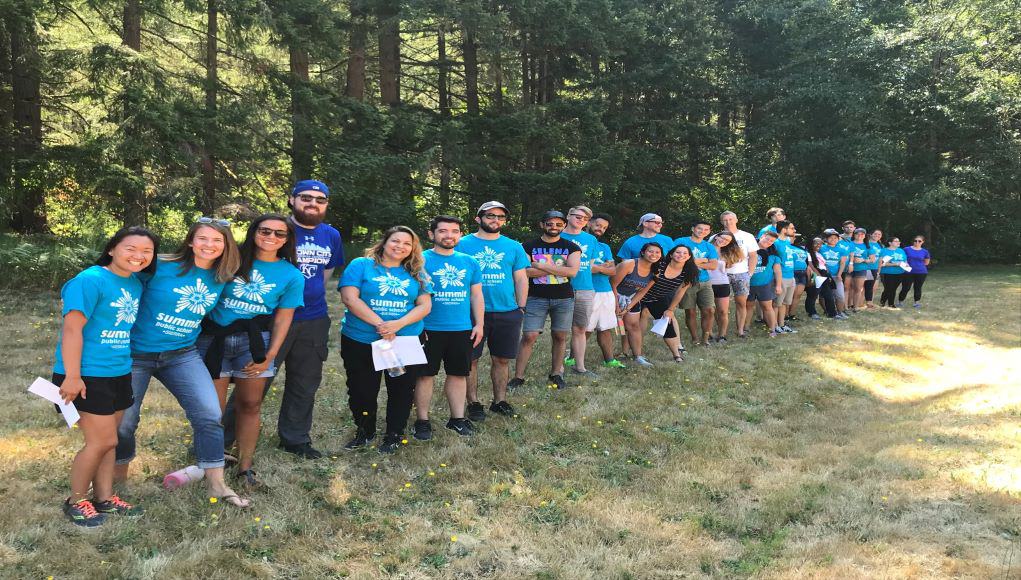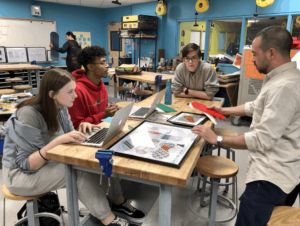Culture Eats Faculty Retention for Breakfast: 7 Essential Tips to Build a Strong School Culture

By: Malia Burns
If you walked into my high school on any given day, you’d see an array of typical scenes. Students focused in class, socializing with peers in the halls during transition periods. Teachers focused on their daily lessons, debriefing with colleagues in the halls. Leaders meeting with faculty and families. A vibrant high school community.
But there’s something else at play that often goes unseen. An intangible element that you can just feel when you step foot onto campus. It’s that extra something that’s harder to pinpoint, and it happens to be the secret ingredient of any high-quality school: strong school culture and a team of adults fiercely committed to student success.
In 2015, I founded Summit Sierra High School in Seattle, Washington. It was a simultaneously challenging and exciting time. The state’s recent voter-passed public charter school law was precariously hanging in the balance and threats of closure was a constant force. Yet, we still managed to open our doors to a fully enrolled freshman class that fall. Since then, our campus culture has solidified and all but one of my founding faculty members remain on the team – showing up for students and for one another, every day.
A pillar of Summit’s personalized learning model is a focus on building relationships. Within that, adults in the building are the beating heart of culture. All teachers are mentors, meeting with a cohort of students one-on-one and in groups regularly. Not only are mentors important advocates for students, but the relationship enables faculty to connect with families as well. This virtuous cycle of mentoring is also prevalent among adults in the school building. As they support students, they begin to organically support one another as well.
In the current 2018-2019 academic year, Summit Sierra is poised to graduate our first seniors – members of Washington state’s inaugural charter high school graduates – alongside teacher-mentors who have tracked with them all four years of their high school careers. As we approach our first graduation in June, I’ve found myself reflecting on how we went from just eight staff members and 100 students to a thriving school with 31 team members serving more than 385 students. And how, despite it all, we’ve enjoyed over 90 percent teacher retention among founding faculty along the way.
No matter how I think about it, I always come back to culture and its foundational role in our staff retention. And to these seven essential and, importantly, scalable ingredients:
1. A sense of place and a commitment to building relationships is key. Spend time getting to know the broader neighborhood around your school. This is especially the case when opening a new school as my founding team and I did in 2015. We did – and still do! – community tours as a team to learn firsthand about the neighborhoods in which our students live. But there’s also something to be said for reacquainting yourself and your team with the community around even the most established of schools. Who are the respected and influential leaders in the area? How is your school meeting an unfilled need within the community? By asking these questions not only do you start to (re)build relationships outside of the school walls, but you also start to use it as a lens to recruit talented teachers, leaders and staff. Will this candidate be a good mentor? Can they be flexible and take responsibility for the school? These are essential questions I’ve continually kept in mind as I’ve hired both my founding faculty and subsequent team members.
Through it all, my school has simultaneously focused on building relationships, trust and support through mentoring – of students and teachers alike. Just as students in Summit participate in mentor cohort “circles” – dedicated times each week where students sit in a literal circle and share their academic and personal issues in an open and supportive environment – so, too, do team members.
2. Focus on intention-setting and mission-fidelity. But don’t forget to remain flexible! This applies in all things, big and small. At my school, infusing a sense of shared ownership is critical; when teachers and students are given ownership over a task, a club or an event, it inherently instills a sense of pride. Our students and teachers are free to create the clubs and extracurriculars that fuel their passion for learning and sense of community. That fervent love of a subject or issue is contagious. Teachers write proposals, create mini-teams, serve on working groups and play a vital role in leading our school. Along the way, we organically boost investment in our school, emphasize mission alignment and, ultimately, usher in improvements on a regular basis.
Culture is a living, breathing thing. As new students or teachers enter the school community, they will invariably leave an indelible – and distinct – mark on the campus. At Summit Sierra, students have formed over 30 clubs and staff has been given the freedom to channel their passions – photography, coding, engineering, you name it – into lessons, extracurriculars, field trips and more. Remaining open and receptive to new ideas, while remaining tied to our intentions and mission, has ultimately strengthened our school culture.
3. Roll with the punches to foster camaraderie. Ours is a campus culture that has had its fair share of ups and downs, like so many K-12 schools. Caught in the middle of a protracted statewide political fight, Summit Sierra rallied to advocate for the school. Leaders, teachers, students, parents, community members – everyone came together repeatedly to support our campus. This built a tremendous shared conviction about our school and an unbreakable bond. Regardless of the challenges your school faces, think about how it can ultimately serve as a lesson that can strengthen your team.
4. Focus on race and equity, every day. Just as our school community is intentional about our sense of purpose and mission, so, too, are we intentional about recognizing and checking our privilege, our commitment to diversity and our mutual respect for one another. We partner with race and equity experts and hold space for intentional discussions on the topic as a team regularly.
5. Remember that the little things add up to big things. It’s vital to take time to celebrate wins, large and small. The work we do as educators is rewarding and fun, but often serious and challenging. An essential part of what keeps Summit Sierra teams motivated is our focus on celebrating wins and milestones every step of the way. Whether it’s schoolwide, congratulating seniors on a 100 percent college acceptance rate, or individually, as a mentor-teacher and mentees high-five over an academic milestone or goal met – we amplify the positive wins in equal measure. And, we build in incentives for students and adults that are genuinely fun.
6. Create a student culture and an adult culture separately. This might sound counterintuitive given everything I’ve already said, but at Summit Sierra we view student and team culture as two separate, yet interrelated, things. For team members, culture should organically mirror the same values instilled in student culture. Our team goes on annual faculty and student camping trips. We connect with colleagues outside of school. Most importantly, we’re genuinely present for one another, celebrating and offering support every step of the way.
7. Culture is a critical lever of student engagement. With my team’s dedicated focus on culture from Day 1, we’ve seen student ownership and, in turn, a sense of leadership blossom. A huge focus of our culture-building has always been centered on empowering students to be leaders. What started in the first weeks of our inaugural year with students creating and voting on our campus mascot and peer-to-peer tutor hub has exponentially grown with each passing school year. Today, we have a student government that organizes the student body and administration to make positive changes in the campus – and, importantly, that builds leadership and public speaking skills in our students. We have a student-run “clean team” that manages beautification efforts in and around our urban school community and that has spearheaded a campus garden. We have a “tech deck” group of student IT troubleshooters that fix Chromebooks. We have a student-led group that hones grassroots communications and marketing expertise leading talent recruitment and family enrollment efforts. And, we cultivate an ongoing spirit of social justice. As recent events arise in Seattle and beyond, our students show up and drive the change they wish to see in the world. They leave a legacy, every day. It’s inspiring and, at times, our culture of promoting student engagement can also help with teacher work-life balance by taking some of the work off adults’ plates in the process.
Every school is unique. And, every student and adult within that school is unique. Channeling that uniqueness into a shared mission, vision, set of goals and looking for ways to build relationships in the process can make all the difference in school culture. And, when school culture is flourishing, enabling individuals to take ownership over aspects of learning, students and teachers feel supported. That support becomes contagious and, before you know it, you have a team of adults committed to sticking around year after year and engaged student leaders leaving a lasting school legacy.
For more, see:
- Building School Culture With Gratitude
- Letting Students Lead School Culture
- 3 Innovative Tips For Tackling School Culture
Malia Burns is the founding executive director of Summit Sierra High School in Seattle, Washington. Follow Summit Public Schools on Twitter at @SummitPS.
Stay in-the-know with innovations in learning by signing up for the weekly Smart Update.






0 Comments
Leave a Comment
Your email address will not be published. All fields are required.